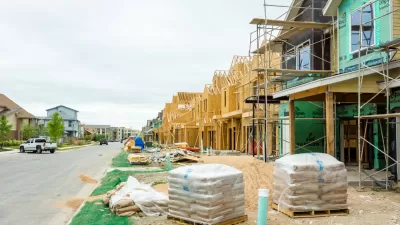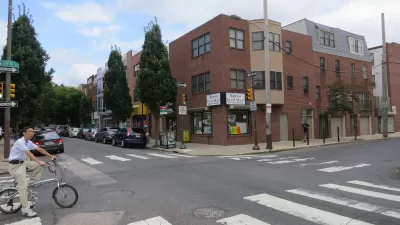A report released this week by the U.S. EPA finds that 71 percent of the country's large metro regions saw an increase in the development of infill housing over the latter half of the last decade. Greenfield development still dominates, however.
The good news in the Environmental Protection Agency's newly released report, "Residential Construction Trends in America's Metropolitan Regions: 2012 Edition" (PDF), is that "infill has become a significant portion of the U.S. housing market." In a press release accompanying the publication of the report, the EPA noted that, "[f]or example, eight out of ten new homes in San Jose, Calif. were infill. New York, Los Angeles, and San Francisco all saw a majority of new home construction in previously developed areas during the same time period."
The bad news? That significant portion accounts for only 21 percent of new home construction, meaning the remaining 79 percent "was built on undeveloped land outside existing communities." Furthermore, finds the report, "[n]early all metropolitan regions are growing outward more than they are growing inward."
Why should we be building more infill? As the EPA notes, "this type of development provides economic and public health benefits to metropolitan areas while protecting the local environment...Infill housing has also been shown to help raise property values, increase a community’s tax base, and attract retail businesses to serve the larger residential population."
FULL STORY: EPA Study Reveals Shift in Housing Developments Across the U.S.

Planetizen Federal Action Tracker
A weekly monitor of how Trump’s orders and actions are impacting planners and planning in America.

Restaurant Patios Were a Pandemic Win — Why Were They so Hard to Keep?
Social distancing requirements and changes in travel patterns prompted cities to pilot new uses for street and sidewalk space. Then it got complicated.

Map: Where Senate Republicans Want to Sell Your Public Lands
For public land advocates, the Senate Republicans’ proposal to sell millions of acres of public land in the West is “the biggest fight of their careers.”

Maui's Vacation Rental Debate Turns Ugly
Verbal attacks, misinformation campaigns and fistfights plague a high-stakes debate to convert thousands of vacation rentals into long-term housing.

San Francisco Suspends Traffic Calming Amidst Record Deaths
Citing “a challenging fiscal landscape,” the city will cease the program on the heels of 42 traffic deaths, including 24 pedestrians.

California Homeless Arrests, Citations Spike After Ruling
An investigation reveals that anti-homeless actions increased up to 500% after Grants Pass v. Johnson — even in cities claiming no policy change.
Urban Design for Planners 1: Software Tools
This six-course series explores essential urban design concepts using open source software and equips planners with the tools they need to participate fully in the urban design process.
Planning for Universal Design
Learn the tools for implementing Universal Design in planning regulations.
Heyer Gruel & Associates PA
JM Goldson LLC
Custer County Colorado
City of Camden Redevelopment Agency
City of Astoria
Transportation Research & Education Center (TREC) at Portland State University
Camden Redevelopment Agency
City of Claremont
Municipality of Princeton (NJ)




























